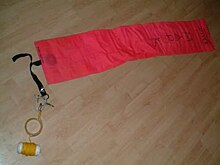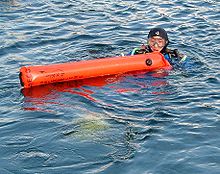Signal buoy
The signal buoy (also diving , diving , safety , marking or decorative buoy , English surface marker buoy , SMB for short ) is a floating body with which divers can make their position on the water surface visible in particular. It is usually filled with breathing gas and is also used as part of diving equipment to transport messages to the surface or to serve as a depth reference during an open water ascent. Furthermore, they are also used by people floating on the surface of the water, especially in rough seas or strong currents, to improve visibility and findability.
construction
A basic distinction is made between two types of signal buoys: the open and the closed buoy. Recreational divers mostly use simple elongated open buoys. They are about one to two meters long and have an opening at the bottom through which they can be filled and through which excess air can escape during the ascent. Technical divers mostly use a teardrop-shaped closed signal buoy. It has a valve and thus prevents the air from escaping unintentionally on the surface. Both variants consist of a tear-resistant, coated plastic fabric and are welded gas-tight. Above and below, the buoy should have options for attaching snap hooks . The lower eyelets or loops are used to connect them to the line that the diver carries on a small reel . He pulls the buoy behind him on the string. The upper eyelets or loops are used to attach messages or a diving flag . Certain water depths are often marked on the line by knots or colored markings. The buoy should have a signal color (red-orange) so that it is clearly visible in the water.
use
inflation
Open buoys are usually inflated with a puff of air from the octopus . Closed buoys are either with the mouth, the connection to the inflator or the dry suit hose inflated. By unrolling the cord from the reel, the buoy then rises to the surface.
Drift diving
In drift dives (drift dive) is often a Tauchboje after the descent inflated to the intended depth to the diver a pursuing boat to show the way. A diver pulls the buoy behind him for the remainder of the dive.
Emergency ascent
If shipping traffic is expected at the point of surfacing, divers can inflate a buoy before initiating the emergency ascent to signal their presence to ships.
Open water ascent
When ascending in open water, the buoy can not only serve to indicate the position of divers to boat crews. The line of the buoy can also be used as a depth reference to keep the depth constant during decompression stops without having to keep an eye on the depth gauge.
On the surface
A diver drifting alone on the surface is very difficult to see, especially at great distances and heavy seas, as he only has his head above the surface. If he holds his signal buoy upright, his silhouette is enlarged and the signal color is easy to see against the blue-green background of the water. By pivoting the buoy, the diver can also transmit an emergency call.
Regulations
In some waters it is mandatory for divers to carry a signal buoy. There are even some places where it is mandatory to inflate a buoy before surfacing.
Individual evidence
- ↑ The Safety Sausage Story ( Memento of the original from July 15, 2007 in the Internet Archive ) Info: The archive link was inserted automatically and has not yet been checked. Please check the original and archive link according to the instructions and then remove this notice. (English), SCUBA Diving Safety Page, accessed June 14, 2011.
- ↑ a b c d Wilke Reints: Buoy & Alertmarker . Dir-m.com website, accessed February 20, 2014.




